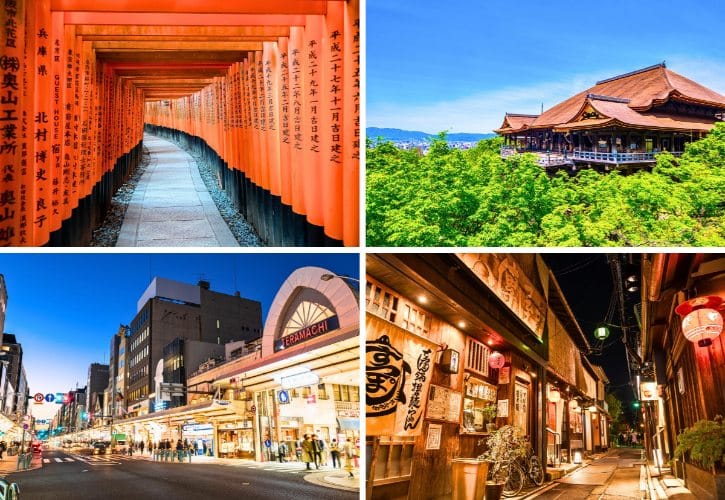
This guide makes your Kyoto day trip from Osaka easy!
I’ll show you how to get there and the best route for seeing popular attractions, saving you time and effort.
Kyoto is a quick train ride away from Osaka, making it perfect for a day trip. Let’s get started! 😊
9:00 AM: Fushimi Inari Shrine
a. Key Highlights

- Discover History: Visit Japan’s most important Inari shrine, popular for over 1,300 years.
- Bring Good Luck: The shrine honors Inari, who grants good fortune and bountiful harvests.
- Enjoy the Views: Thousands of bright orange gates line the paths, creating stunning sights.
- Wander Through Gates: Walk through magical tunnels that wind gently up Mount Inari.
b. Exploring the Main Shrine
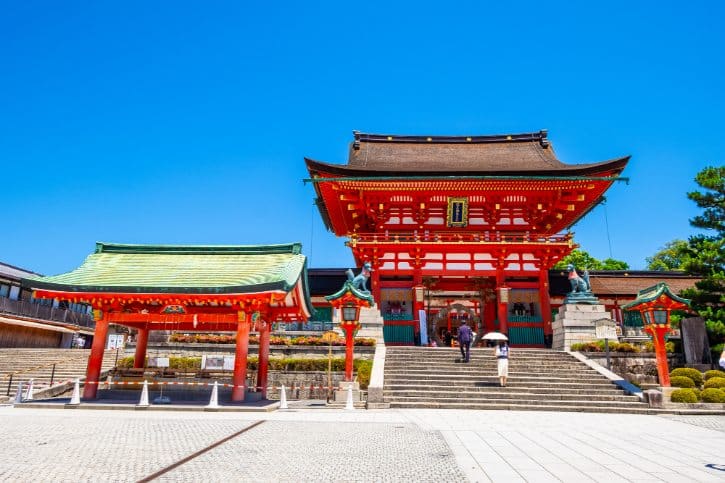
- Start at Romon Gate: Begin your visit at this impressive gate, built by leader Toyotomi Hideyoshi in 1589.
- Offer Your Wishes: Pause at the main hall to quietly pray or show your respect.
- Spot the Foxes: Look out for friendly fox statues. They deliver your prayers and wishes to Inari.
- Read Others’ Wishes: Take a moment to read the wooden “ema”, where visitors share their hopes.
- Find Something Special: Write your wish on a fox-shaped prayer board. You won’t find these anywhere else!
Read More: Visiting Fushimi Inari Shrine in Kyoto: Your Complete Guide
c. How to Get from Osaka to Fushimi Inari Shrine
i. From Namba
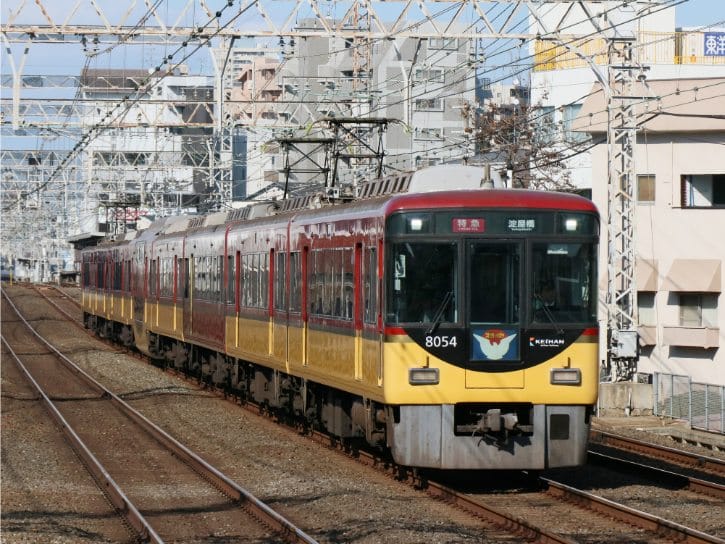
- From Namba Station, take the Osaka Metro Midosuji Line to Yodoyabashi Station.
- At Yodoyabashi Station, transfer to the Keihan Main Line (Rapid Limited Express/ Limited Express) toward Demachiyanagi.
- Get off at Fushimi-Inari Station and exit via the East Gate. The shrine is just a short walk from there.
- The journey takes about 1 hour and costs ¥610.
ii. From Umeda

- From Osaka Station (in the Umeda area), take the JR Kyoto Line’s Special Rapid Service (Tokaido-Sanyo Line) toward Kyoto Station. Be sure to choose the “Special Rapid Service” since it’s the fastest option.
- At Kyoto Station, transfer to the JR Nara Line (local train) heading toward Inari Station.
- Get off at Inari Station. Fushimi Inari Shrine is directly in front of the station exit.
- The journey takes about 50 minutes and costs ¥860.
Read More: Osaka to Kyoto: The Best Transport Options
11:45 AM: Togetsukyo Bridge
a. Key Highlights
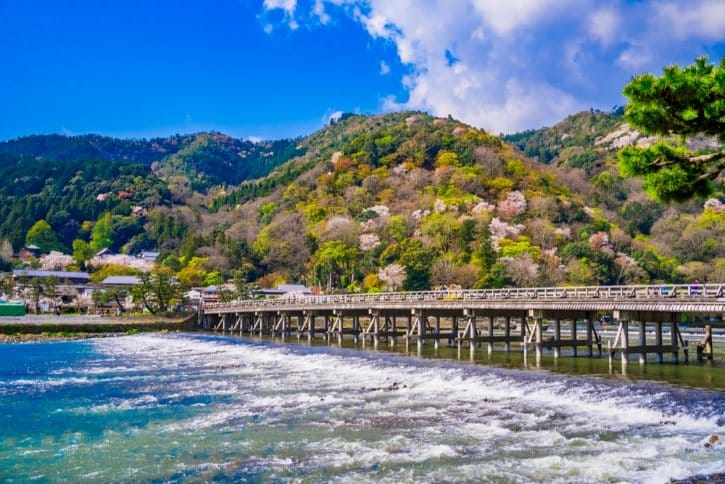
- Location: A famous bridge crossing the Katsura River in Arashiyama.
- Name Origin: Called “Moon Crossing Bridge” because an ancient emperor thought the moon looked like it was crossing over the bridge.
- Scenery: From the bridge, you can enjoy beautiful views of the Katsura River and surrounding mountains.
- Best Visiting Times: Spring for cherry blossoms and autumn for colorful leaves.
b. Things to Do at the Bridge
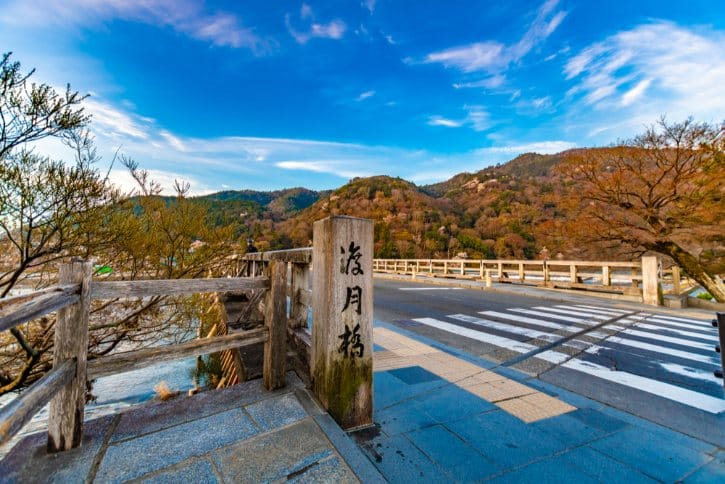
- Photos: Capture great pictures of the bridge and its beautiful surroundings.
- Walk: Cross the bridge on foot while taking in scenic mountain views.
- Rickshaw Ride: Experience something unique by taking a relaxing rickshaw ride guided by a friendly local.
c. How to Get from Fushimi Inari Shrine to Togetsukyo Bridge
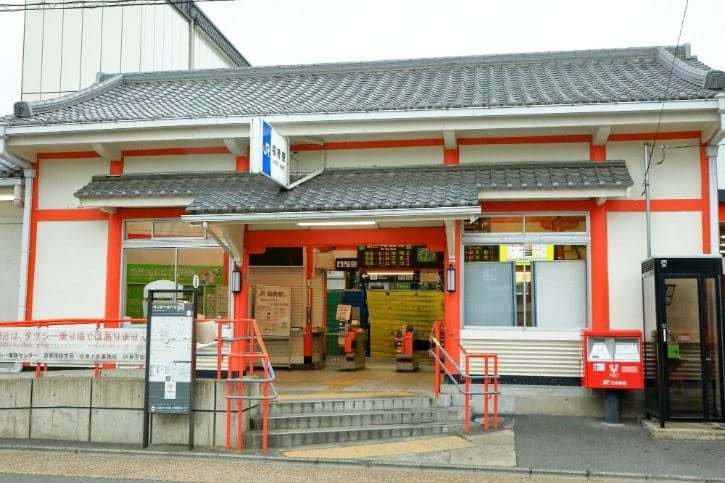
- From Fushimi Inari Shrine, walk to Inari Station (JR Nara Line).
- At Inari Station, take the JR Nara Line train to Kyoto Station.
- At Kyoto Station, transfer to the JR Sagano Line (JR San-in Line) and get off at Saga-Arashiyama Station.
- From Saga-Arashiyama Station, walk directly to Togetsukyo Bridge (about 10–15 minutes).
- The entire journey takes about 50 minutes and costs ¥240.
Remark:
You can also take a taxi directly from Fushimi Inari Shrine to Togetsukyo Bridge. The fare is around ¥5,000.
11:45 AM: Arashiyama Yoshimura (Lunch)
Arashiyama Yoshimura in Kyoto offers tasty soba noodles in a scenic spot overlooking the famous Togetsukyo Bridge and nearby mountains.
a. Delicious Soba Dishes You’ll Love
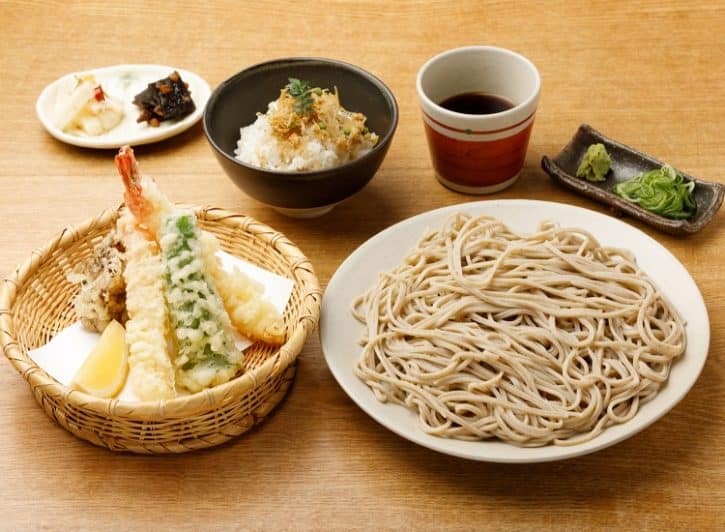
- Freshly Made Noodles: The soba noodles are handmade daily using high-quality Japanese buckwheat flour.
- Popular Set: The Tenzaru Zen set includes soba noodles, assorted tempura, special herring rice, and traditional pickles.
- Chilled Soba: Cold noodles served with dipping sauce, ideal on hot days.
- Hot Soba: Warm soba served in soup, great for colder weather.
- Seasonal Specials: Special soba dishes available depending on the season.
b. Crispy, Fresh Tempura Favorites
- Fresh and Crispy: Tempura made daily with fresh ingredients.
- Popular Choice: Mixed tempura plate with seasonal vegetables and seafood.
- Kakiage Tempura: A tasty fried patty made from vegetables and seafood.
- Easy Add-on: You can add tempura to your meal or order it separately.
- Vegetarian Option: Vegetable tempura is available for vegetarians.
c. Great Value and Pricing Information
- Average Cost: Around ¥1,800 to ¥3,000 per person.
- Best Value: Choose set meals to enjoy noodles, tempura, and side dishes at the best price.
d. How to Get from Togetsukyo Bridge to Arashiyama Yoshimura

From Togetsukyo Bridge, walk north along the riverside for about 2 minutes to reach Arashiyama Yoshimura.
12:30 PM: Arashiyama Bamboo Forest
a. Key Highlights
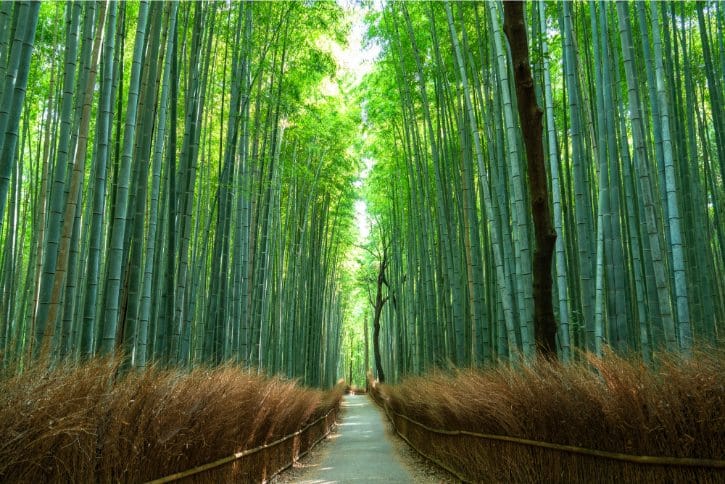
- Bamboo Trees: Tall green bamboo trees that reach high into the sky
- Forest Path: A lovely path takes you right through the bamboo forest
- Popular Photo Spot: One of Kyoto’s most photographed locations, seen on many postcards
- Gentle Sounds: Enjoy the relaxing sounds of bamboo leaves swaying softly in the wind
b. Exploring the Bamboo Grove
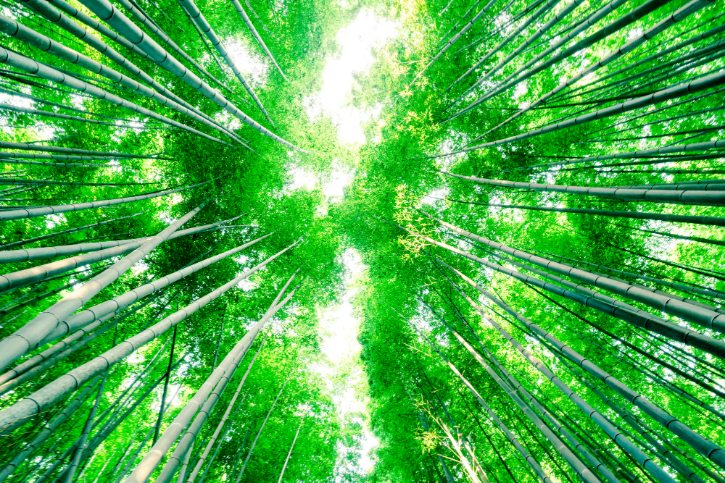
- Short Walk: The main path is short, about 300 meters, taking roughly 5 minutes to walk
- Look Up: Remember to look upwards to fully appreciate how tall the bamboo grows
- Listen Carefully: Stop and listen to the calming sound of bamboo rustling in the breeze
- Relax and Enjoy: Take your time and enjoy the peaceful setting, even if it gets a little crowded
c. Tips for Great Photos
- Wide-Angle Lens: Bring a wide-angle lens to capture the impressive height of the bamboo
- Point Upwards: Aim your camera up for beautiful pictures of the bamboo canopy
- Morning Light: Visit in the early morning for the best sunlight filtering through the bamboo trees
Read More: Top 17 Things to Do in Kyoto
d. How to Get from Arashiyama Yoshimura to Arashiyama Bamboo Forest
From Arashiyama Yoshimura, head north and follow the main street for about 5 minutes to reach the entrance of the Arashiyama Bamboo Forest.
1:00 PM: Tenryuji Temple
a. Key Highlights
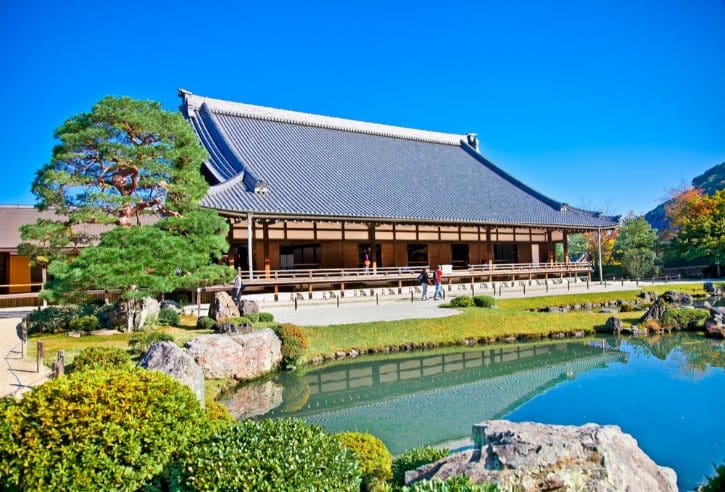
- UNESCO Heritage: Tenryuji is a UNESCO World Heritage Site and one of Kyoto’s five great Zen temples.
- Sogenchi Garden: Famous garden designated as a national historic treasure, known for its peaceful beauty.
- Hojo Building: The head priest’s residence, showcasing traditional Japanese architecture.
- Hatto Hall: Main hall featuring a well-known dragon painting on the ceiling.
- Kuri Building: Monks’ living quarters with a lovely tower and unique Daruma painting.
b. Top Sights to Enjoy
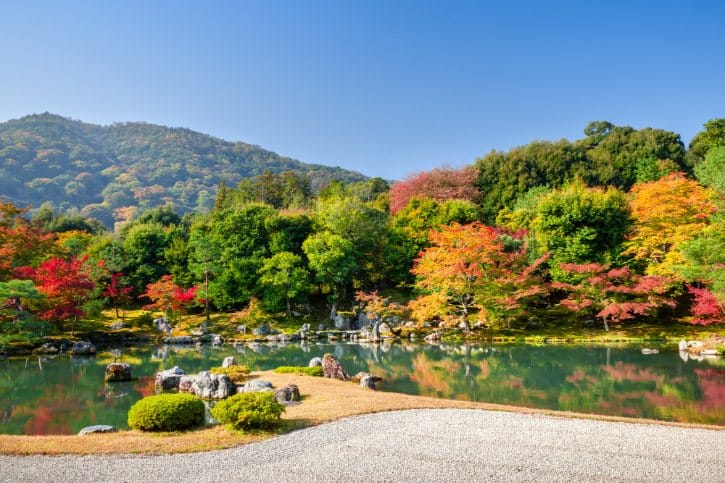
- Sogenchi Garden: Take a relaxing stroll around this garden created by Muso Soseki, featuring a serene pond at its center.
- Kuri Entrance: Start here to buy your ticket and see the special Daruma painting.
- Hojo Visit: Explore the Hojo building and enjoy its beautiful design and garden views.
- Hatto Hall: Don’t forget to look up at the impressive dragon painting on the ceiling.
c. How to Get from Arashiyama Bamboo Forest to Tenryuji Temple
From the Arashiyama Bamboo Forest, head south along the main path for about 3 minutes to reach the north entrance of Tenryuji Temple.
This entrance is conveniently located adjacent to the bamboo grove, making it easily accessible.
2:40 PM: Kinkakuji (Golden Pavilion Temple)
a. Key Highlights
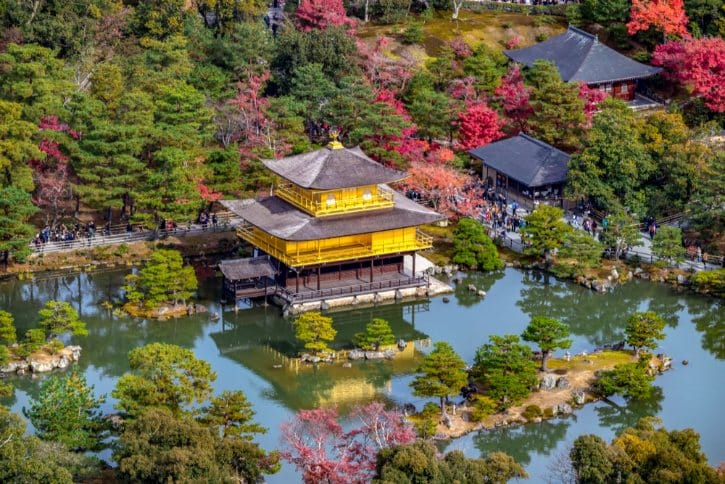
- Golden Temple: A beautiful temple covered in real gold leaf that shines brightly in the sunlight.
- Mirror Image: The temple reflects perfectly in the pond, making it ideal for amazing photos.
- Peaceful Gardens: Surrounded by a quiet, traditional Japanese garden.
- Kyoto Landmark: One of Kyoto’s most famous and easily recognizable places.
b. What to Explore and Enjoy
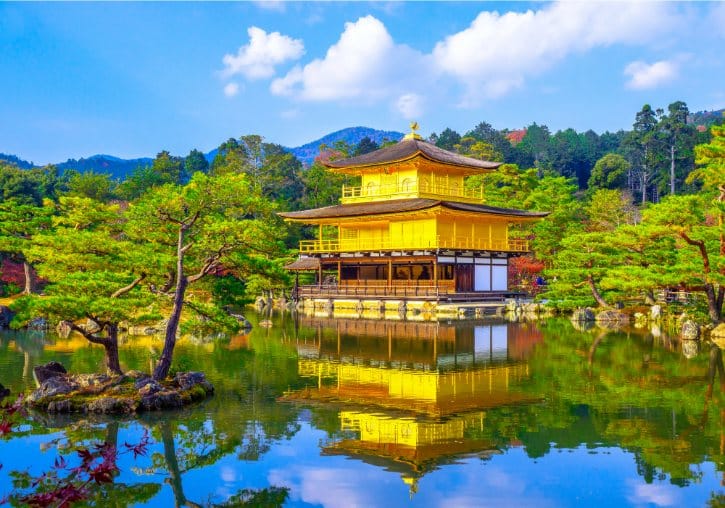
- Photography: Take great photos of the golden temple reflecting clearly on the water.
- Golden Phoenix: Look at the temple’s roof to spot the golden phoenix statue at the very top.
- Outside View: Explore and enjoy views from outside, since the temple interior isn’t open to the public.
- Walk Around: Take a relaxing walk around the pond to see the temple from different angles.
c. Wandering Through the Gardens
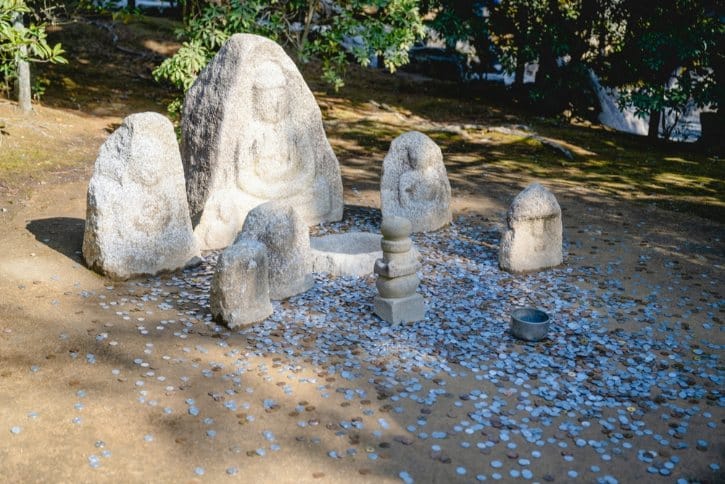
- Good-luck Statues: Toss a coin and make a wish at the statues for good luck.
- Visitor Path: Follow the marked path to find the best spots and views.
- Anmintaku Pond: Visit this special pond known for its water that never dries up.
- Relax: Take your time and enjoy the peaceful beauty of the garden.
Read More: 10 Most Beautiful Places to Visit in Kyoto
d. How to Get from Tenryuji Temple to Kinkakuji
- From Tenryuji Temple, walk to the Arashiyama Tenryuji-mae bus stop.
- Take Kyoto City Bus No. 11 and get off at Yamagoe Nakacho bus stop.
- At Yamagoe Nakacho, transfer to Kyoto City Bus No. 59 toward Kinkakuji-michi.
- Get off at Kinkakuji-michi bus stop, then walk about 2 minutes to reach Kinkakuji Temple.
- The entire journey takes about 42 minutes and costs ¥460.
Remark:
Alternatively, you can take a taxi directly from Tenryuji Temple to Kinkakuji Temple. The ride takes about 20 minutes and costs approximately ¥3,000.
4:30 PM: Kiyomizudera Temple
a. Key Highlights
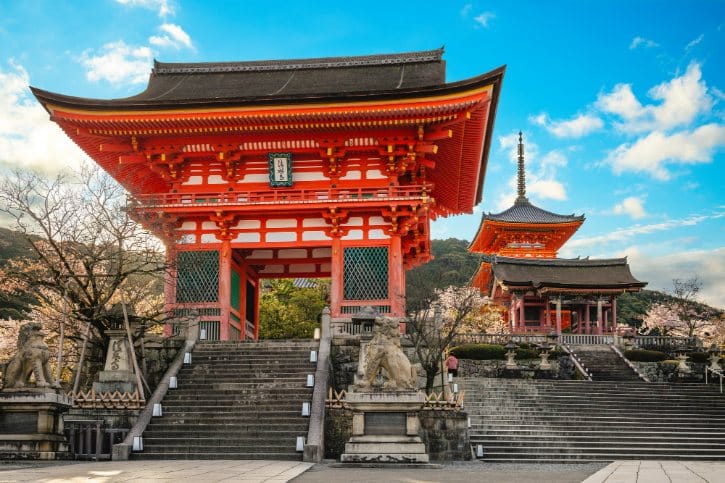
- History: Kiyomizudera Temple was founded in 780 AD and is one of the most popular temples in Kyoto.
- UNESCO Status: The temple is culturally important and is listed as a UNESCO World Heritage Site.
- Name Origin: Its name means “Pure Water Temple”, named after the clear natural spring found here.
- Location: The temple sits high on a hill, offering beautiful views over Kyoto city.
b. Top Sights to Explore
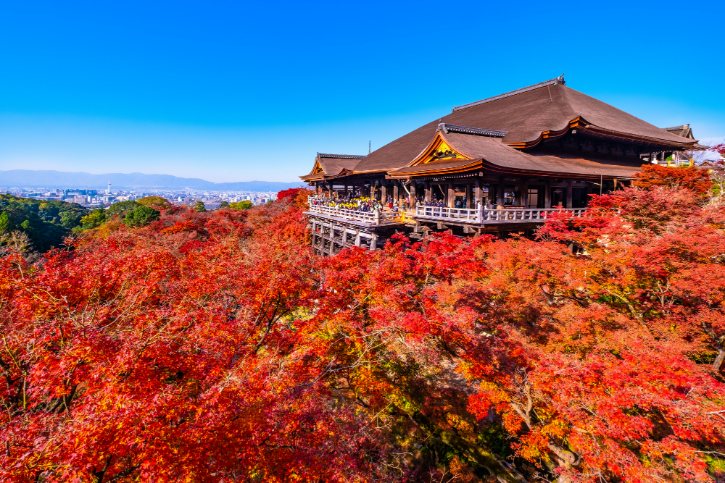
- Best Seasons: Visit during spring for cherry blossoms or autumn to enjoy red maple leaves.
- Main Hall Stage: Don’t miss the wooden stage at the Main Hall. It’s 13 meters high and has great views of the city.
- Pagoda: At the entrance, you’ll see a tall 31-meter pagoda that towers above you.
- Jishu Shrine: Stop at Jishu Shrine, a place where people come to wish for luck in love.
c. Experiences You’ll Love
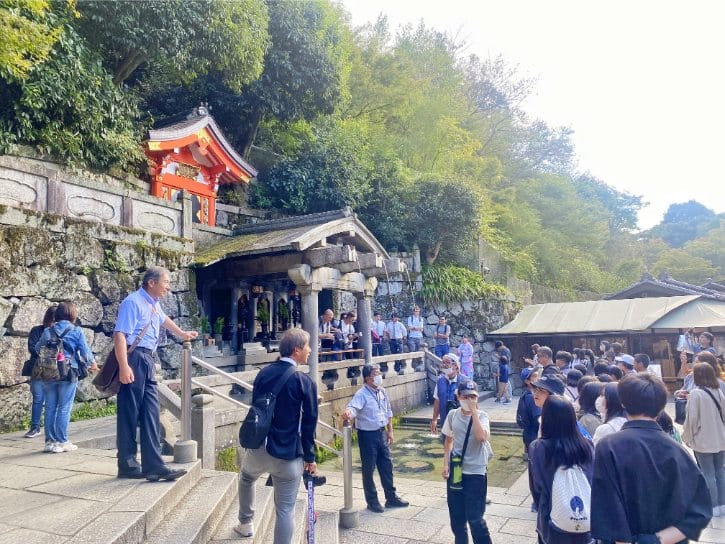
- Otowa Waterfall: Visit Otowa Waterfall, known for its three streams of clear water:
- Drink from the first stream for good health.
- Choose the second stream for success in life.
- Pick the third stream for good luck in love.
- (Tip: Only drink from one stream. Drinking from all three is said to bring bad luck!)
- Temple Bells: Join in the tradition of ringing the temple bells and leaving a small offering at the Main Hall.
- Love Stones: Try walking between two special stones at Jishu Shrine with your eyes closed. If you reach the other side safely, you’ll have good luck in romance.
d. How to Get from Kinkakuji to Kiyomizudera Temple
- From Kinkakuji Temple, walk to the Kinkakuji-michi bus stop.
- Take Kyoto City Bus No. 204 and get off at Nishinokyo Enmachi bus stop.
- At Nishinokyo Enmachi, transfer to Kyoto City Bus No. 202 toward Kiyomizumichi.
- Get off at Kiyomizumichi bus stop, then walk about 11 minutes to reach Kiyomizudera Temple.
- The entire journey takes around 1 hour and costs ¥460.
Remark:
Alternatively, you can take a taxi directly from Kinkakuji Temple to Kiyomizudera Temple. The ride takes about 30 minutes and costs approximately ¥3,500.
6:20 PM: Pontocho Alley (Dinner)
a. Key Highlights

- Historical Street: One of Kyoto’s oldest entertainment streets, dating back to 1670.
- Riverside Location: A charming, narrow street along the Kamo River.
- Traditional Restaurants: Filled with traditional Japanese restaurants and tea houses.
- Geisha Community: Famous for its community of geishas and apprentice geishas (maikos).
- Scenic Atmosphere: Beautiful lanterns and stone-paved streets create a special atmosphere, especially at night.
b. Things to See and Do
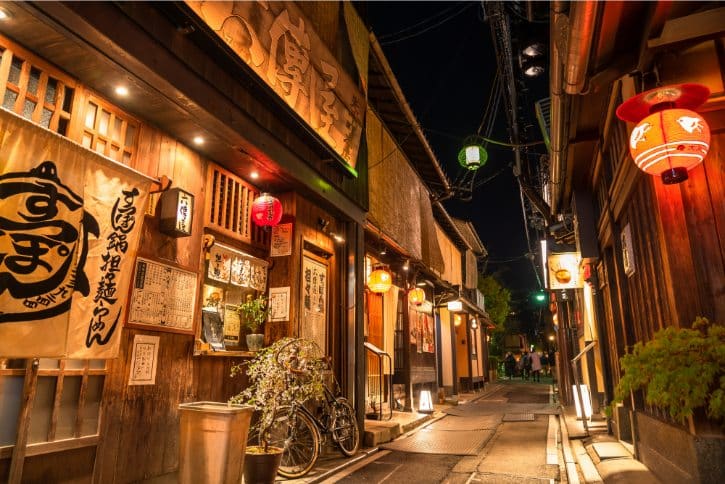
- Scenic Walk: Take a stroll along the street lined with traditional wooden buildings.
- Traditional Shows: Watch traditional dance performances at Pontocho Kaburenjo Theater, especially in May.
- Hidden Alleys: Explore the small, hidden alleys branching off the main street.
- Evening Photos: Take beautiful photos when lanterns light up the street at night.
- Geisha Spotting: You might see geishas or maikos. Remember to be respectful and give them space.
c. Recommended Dinner Spots
i. Kappa Sushi
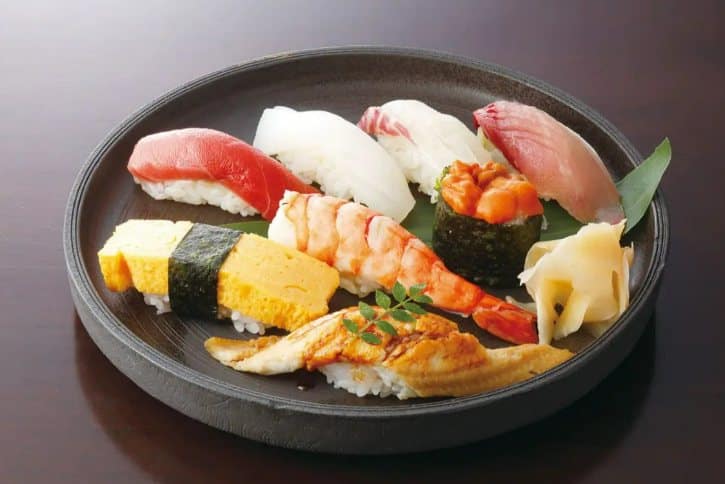
- Affordable Sushi: Conveyor-belt sushi restaurant with reasonable prices.
- Live Preparation: Watch sushi being freshly made at the counter.
- Best Dishes: Rich Southern Bluefin Tuna, Red Sea Bream with citrus, Fresh Yellowtail, Big Shrimp, and Hokkaido Abalone.
- Popular Extras: Fried Pacific Saury with mayo sauce, Special 5-piece sushi set.
- Budget: About ¥1,500 – ¥2,500 per person.
ii. Kichi Kichi Omurice
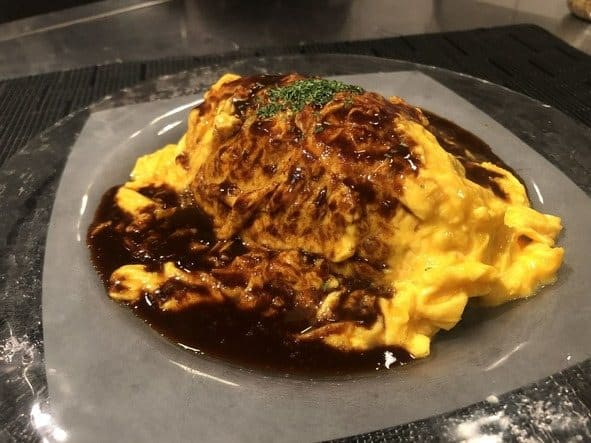
- Famous Omurice: Popular restaurant known for fluffy omelette rice and entertaining cooking demonstrations.
- Must-Try: Special omurice topped with silky egg and tasty brown sauce.
- Preparation Styles: Choose from the classic knife-cut or the fun flying style.
- Other Good Choices: Small-sized omurice, Hearty Beef Stew, Crispy Chicken Cheese Cutlet.
- Budget: Small portion costs ¥1,450, and full meals cost around ¥2,700 – ¥3,250.
iii. Kyoto Yakiniku Hiro Pontocho
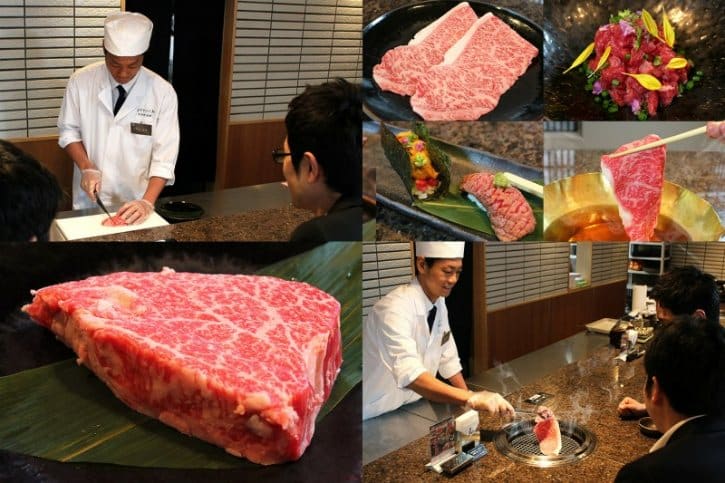
- Grill Your Own Beef: Enjoy grilling premium Japanese beef right at your table.
- Top Recommendation: Mixed platter featuring different cuts of Wagyu beef.
- Fan Favorites: Tender beef tongue, flavorful short ribs, and seasonal vegetables.
- Budget: About ¥5,000 – ¥8,000 per person.
d. How to Get from Kiyomizudera Temple to Pontocho Alley
- From Kiyomizudera Temple, walk to the Kiyomizumichi bus stop.
- Take Kyoto City Bus No. 207 and get off at Shijo Keihan-mae bus stop.
- From Shijo Keihan-mae bus stop, walk about 8 minutes to reach Pontocho Alley.
- The entire journey takes about 25 minutes and costs ¥230.
7:00 PM: Gion and Shijo Street
a. Key Highlights
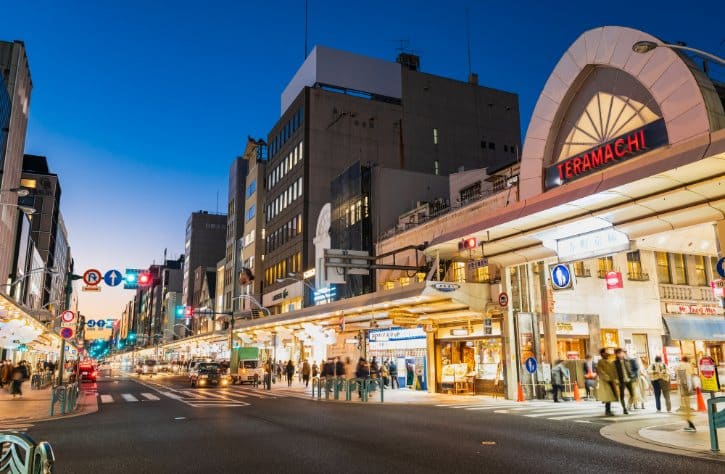
- Gion’s Geisha District: Shijo Street is in the center of Kyoto’s famous geisha district. You might spot real geisha (geiko) or apprentices (maiko) in the evenings heading to appointments.
- Shopping on Shijo Street: Offers a mix of traditional shops selling Kyoto crafts, sweets, and souvenirs alongside modern boutiques.
- Hanamikoji Street: Iconic street with traditional wooden buildings, many now upscale restaurants and tea houses. Great place for evening walks.
- Minamiza Kabuki Theater: Historic theater at the western end of Gion offering traditional Japanese kabuki performances. Worth visiting even just to see the outside.
b. What to Explore and Enjoy
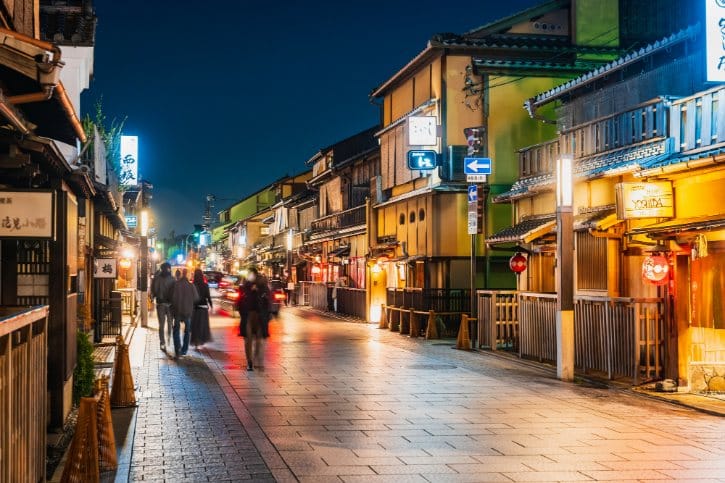
- Hanamikoji Walk: Enjoy a stroll on this historic street, especially beautiful in the evening.
- Shirakawa Canal Area: Peaceful area north of Shijo with willow trees, traditional houses, and cherry blossoms in spring.
- Tatsumi Bridge: Scenic small bridge near Shirakawa Canal, perfect for photos.
- Green Tea: Purchase high-quality Uji matcha tea from well-known shops like Gion Tsujiri, located near the southern part of Shijo Street. They also offer matcha sweets and desserts.
- Traditional Crafts: Buy Kyoto-style folding fans, silk accessories, and handmade pottery from specialty craft shops along Shijo Street.
- Department Stores (Takashimaya and Daimaru): Located at Shijo-Kawaramachi intersection (western side of Shijo Street). Excellent places to find a variety of Kyoto snacks, sweets, crafts, and gift items.
c. How to Get from Pontocho Alley to Gion and Shijo Street
From Pontocho Alley, Gion and Shijo Street are both an easy 5-minute walk away, with no transportation cost.
8:30 PM: Return to Osaka
a. Returning to Namba
i. From Kyoto-Kawaramachi Station
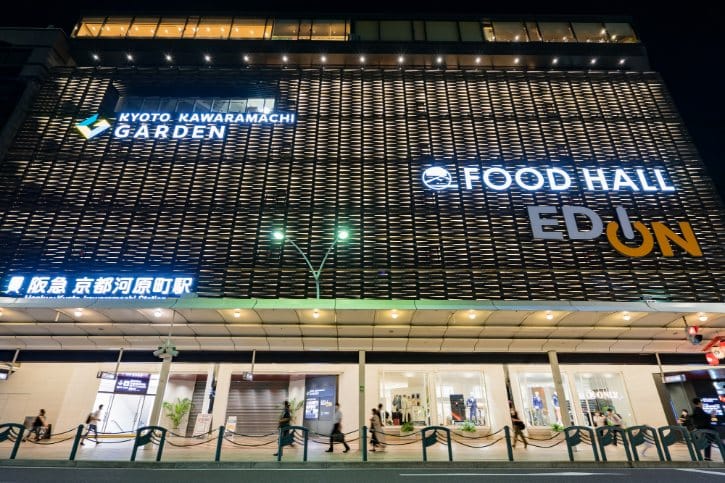
- From Kyoto-Kawaramachi Station, take the Hankyu Kyoto Main Line Limited Express train to Osaka-Umeda Station.
- At Osaka-Umeda Station, walk to Umeda Station and transfer to the Osaka Metro Midosuji Line heading toward Namba.
- Stay on the train until you arrive at Namba Station.
- The journey takes around 55 minutes and costs ¥650.
ii. From Gion-Shijo Station
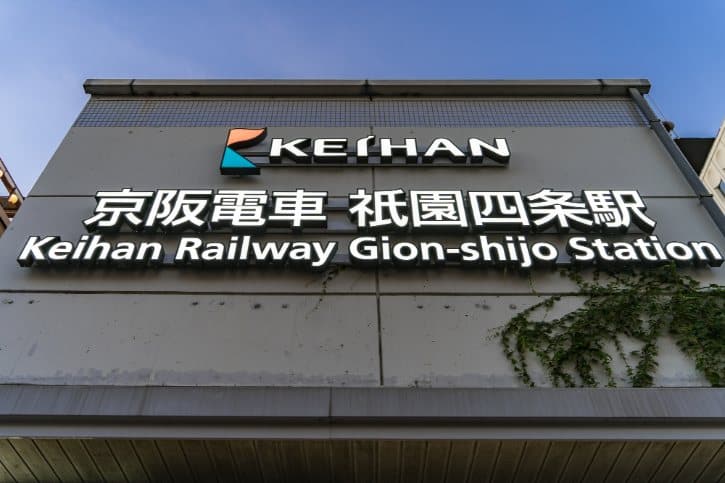
- From Gion-Shijo Station, take the Keihan Main Line (Rapid Limited Express/ Limited Express) to Yodoyabashi Station.
- At Yodoyabashi Station, transfer to the Osaka Metro Midosuji Line heading toward Namba.
- Stay on the train until you reach Namba Station.
- The journey takes about 55 minutes and costs ¥620.
b. Returning to Umeda
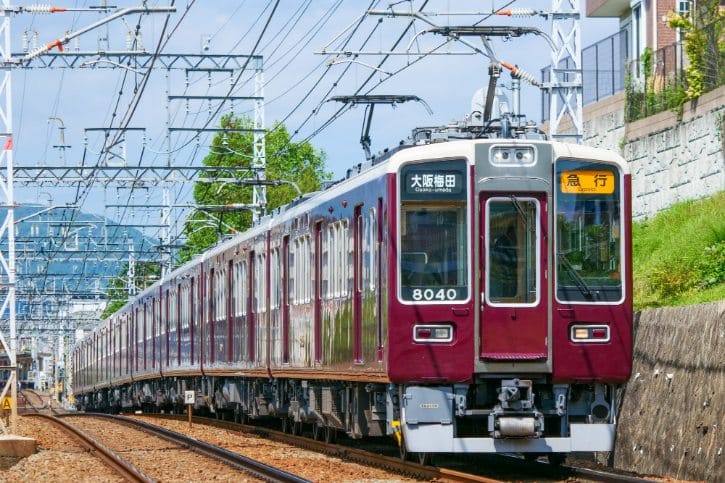
- From Kyoto-Kawaramachi Station, take the Hankyu Kyoto Main Line Limited Express train heading toward Osaka-Umeda Station.
- Stay on the train until you reach Osaka-Umeda Station, which is the last stop.
- The journey takes about 42 minutes and costs ¥410.
Read More: The Perfect 3-Day Osaka Itinerary
Related Posts
Photo Credit:
Photos by PIXTA

